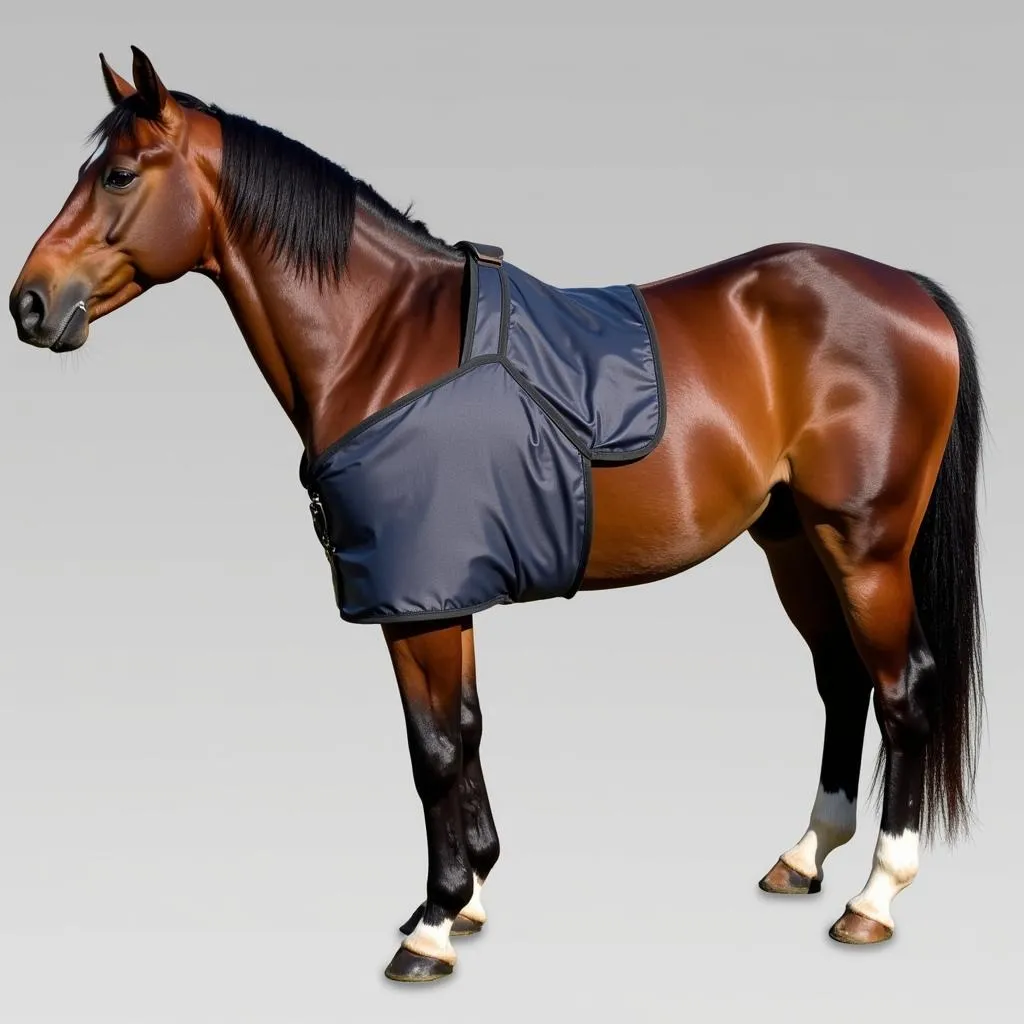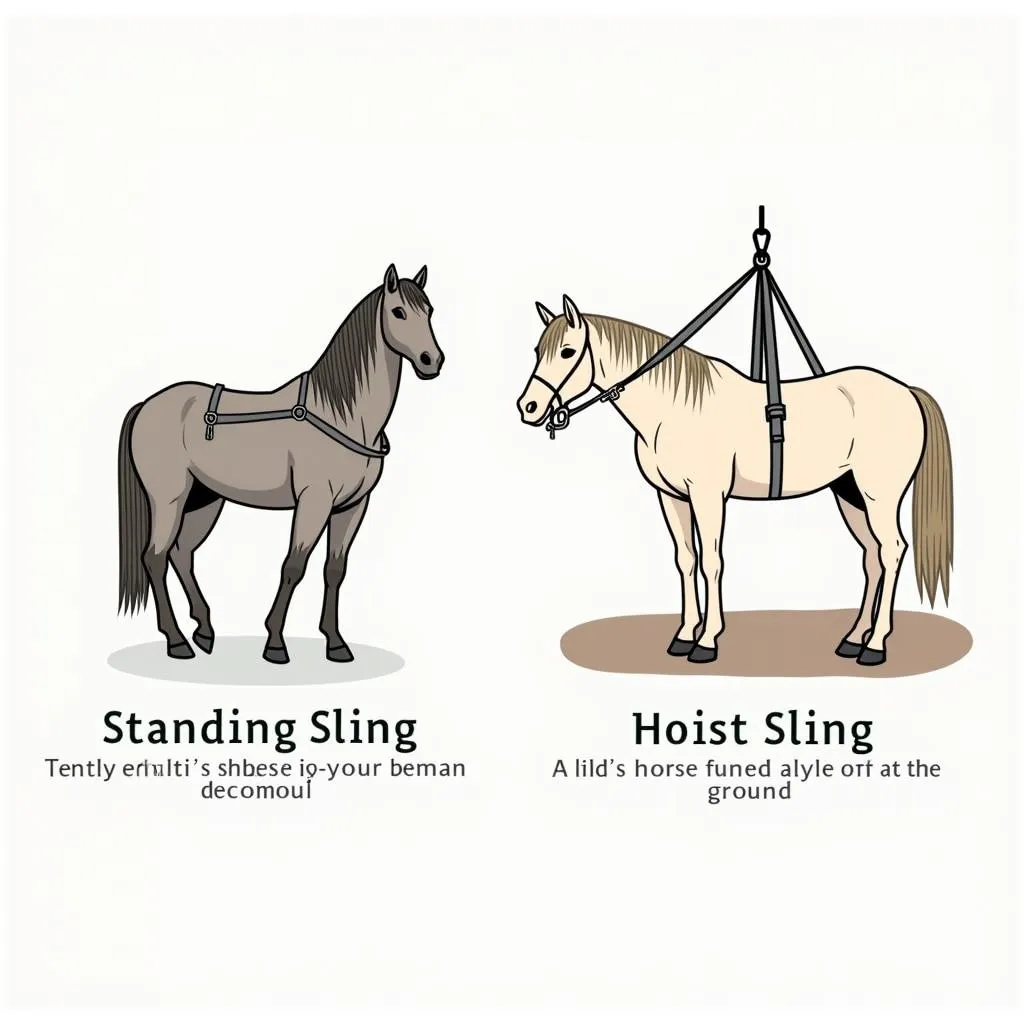A Horse In A Sling might seem unusual at first glance, but this valuable tool plays a crucial role in equine care and recovery. Whether providing temporary support or assisting with rehabilitation, a sling can be a lifeline for horses facing various challenges. This article delves into the world of horse slings, exploring their purposes, benefits, risks, and essential considerations for their safe and effective use.
What is a Horse Sling, and Why is it Used?
A horse sling is a supportive device designed to help horses that are unable to stand or bear weight on their own. Imagine it as a gentle hammock that provides stability and prevents injury. They are used in a variety of situations, including:
-
Post-Surgery Recovery: After undergoing surgery, some horses may experience weakness or instability, making it difficult for them to stand unassisted. A sling helps them stay upright, reducing strain on healing tissues and minimizing the risk of further injury.
-
Injury Support: Horses suffering from leg injuries, tendon or ligament damage, or neurological conditions may benefit from the support of a sling. It allows them to rest and heal while reducing stress on the injured area.
-
Emergency Situations: In emergency cases like a down horse that can’t get up, a sling can be a crucial tool for getting the horse back on its feet and preventing further complications.
 Horse in a Sling Post Surgery
Horse in a Sling Post Surgery
Types of Horse Slings and How They Work
There are two main types of horse slings, each with its own mechanism and applications:
-
Standing Sling: This type of sling is typically used for horses that need assistance standing but can still partially support their weight. It functions by gently lifting and supporting the horse’s abdomen, preventing them from collapsing. Standing slings are commonly used during recovery from anesthesia, after limb casting, or for horses with neurological conditions.
-
Hoist Sling: A hoist sling is a more heavy-duty option designed to lift a horse completely off the ground. This type of sling is used for horses that cannot bear any weight on their limbs and require full support. Hoist slings are typically employed in emergency situations, for transportation, or for short-term use during critical care.
 Types of Horse Slings: Standing and Hoist
Types of Horse Slings: Standing and Hoist
Benefits of Using a Horse Sling
Employing a sling in appropriate situations offers several advantages:
- Reduced Injury Risk: Slings minimize the risk of further injury by providing support and preventing falls, especially during recovery periods when horses are vulnerable.
- Improved Healing: By reducing strain on injured areas, slings promote blood circulation and create a more conducive environment for healing.
- Increased Comfort: Slings offer relief from pain and discomfort associated with standing for prolonged periods, particularly for horses recovering from surgery or injury.
- Facilitated Treatment: Using a sling can make it easier for veterinarians and caregivers to administer medications, conduct examinations, and provide necessary care.
Potential Risks and Precautions
While horse slings offer numerous benefits, it’s vital to be aware of the potential risks and take necessary precautions:
- Pressure Sores: Prolonged use of a sling can lead to pressure sores, especially on bony prominences. Regular inspection and proper padding are essential to prevent this issue.
- Circulatory Problems: Incorrect sling placement or prolonged suspension can impede blood circulation. It’s crucial to ensure proper fit and allow for regular breaks.
- Muscle Atrophy: Extended periods in a sling can contribute to muscle atrophy due to lack of use. Veterinarians often recommend physiotherapy and gradual weight-bearing exercises to counteract this.
 Horse in Sling with Veterinarian
Horse in Sling with Veterinarian
Essential Considerations for Safe Sling Use
To ensure the well-being of your horse while using a sling:
- Consult a Veterinarian: Never attempt to use a sling without the guidance of a qualified veterinarian. They will determine if a sling is appropriate for your horse’s condition and advise on the type, size, and duration of use.
- Proper Fitting and Padding: Ensure the sling is fitted correctly and adequately padded to prevent pressure sores and discomfort.
- Regular Monitoring: Regularly check the horse’s vital signs, skin condition, and overall comfort while in the sling. Report any concerns to your veterinarian immediately.
- Gradual Introduction: Introduce the sling gradually, allowing your horse to acclimate to the sensation of being supported.
- Controlled Environment: Use the sling in a safe and controlled environment, such as a stall with soft bedding, to minimize the risk of injury in case of a fall.
Conclusion
A horse in a sling is not a sight you see every day, but this valuable tool plays a crucial role in equine care. By providing support, facilitating healing, and enabling recovery, slings contribute to the well-being of horses facing various health challenges. However, responsible use, guided by a veterinarian’s expertise, is paramount to ensure safety and effectiveness. If your horse requires a sling, remember that proper care and vigilance are key to a successful outcome.
FAQs about Horse Slings
1. How long can a horse stay in a sling? The duration varies depending on the horse’s condition and the veterinarian’s recommendations. Short periods, several times a day, are typical for standing slings. Hoist slings are used for shorter durations due to their more restrictive nature.
2. Can horses sleep in slings? While horses might doze lightly, they don’t typically sleep soundly in slings. The sling’s support is primarily for standing and short-term rest.
3. Are horse slings expensive? Costs vary based on type, size, and brand. Standing slings are generally more affordable than hoist slings.
4. Do horses need sedation to be put in a sling? It depends on the horse’s temperament and the situation. Some horses tolerate sling placement calmly, while others might require mild sedation.
5. What should I do if my horse falls while in a sling? Immediately remove the sling and contact your veterinarian for guidance.
Do you have more questions about horse care or need assistance with equine health? Contact Justus Horses USA at 0772127271 or [email protected]. You can also visit us at QGM2+WX2, Vị Trung, Vị Thuỷ, Hậu Giang, Việt Nam. Our dedicated team is available 24/7 to address your concerns and provide expert support.